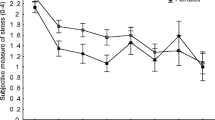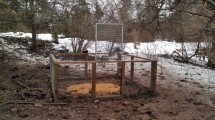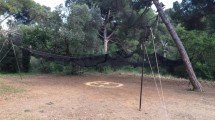Abstract
Wildlife management and research programmes often rely on the capturing of live animals. All capture methods for wildlife involve a risk of injury. For that reason, monitoring of injuries should be completed concurrently, and efficiently, throughout the intervention programme, or study period, to uphold welfare standards. Here, we present a practical adaptive management system to monitor trap-related injuries as a component of broader attempts to maintain welfare standards. The monitoring system described is part of a large-scale tuberculosis-control management programme of European badgers (Meles meles) in the Republic of Ireland. Badgers were captured in stopped cable restraints. A standardised operating procedure was developed to allow for the necropsy of large numbers of badgers (N = 18,596) by a veterinary pathologist. As part of this programme, badger injury status was evaluated using a categorical severity scale ranging from 0 (no impact due to capture) to 6 (death) for badgers captured in restraints. No restraint-related deaths were recorded over the study period. Eighty-four percent of captured badgers exhibited no impact or only superficial hair/skin compression (scale 0–1). Logistic models indicated that injury severity was significantly influenced by year, season, age class, gender, weight and the body position where the badger was captured. Despite the low prevalence of severe injuries recorded, the proportion of animals with a minor injury type (skin oedema; scale 2) increased during the study period. This highlights the need for continual sensitive welfare vigilance during prolonged programmes. We suggest improvements to the current programme and additional adjustments for future vaccination campaigns. We contend that this type of monitoring, coupled with adaptive management strategies, is essential for wildlife programmes to maintain high animal welfare standards, at least in terms of injuries, but also highlight that trap injuries are only one component of animal welfare. We suggest that this adaptive management system could serve as a template for other similar wildlife programmes.



Similar content being viewed by others
References
Arnemo JM, Ahlqvist P, Andersen R, Berntsen F, Ericsson G, Odden J, Brunberg S, Segerström P, Swenson JE (2006) Risk of capture-related mortality in large free-ranging mammals: experiences from Scandinavia. Wildl Biol 12:109–113
Bourne FJ, Donnelly C, Cox D et al (2007) Final report of the Independent Scientific Group on Cattle TB. Department for Environment, Food and Rural Affairs, London
Byrne AW, O’Keeffe J, Green S, Sleeman DP, Corner LAL et al (2012) Population estimation and trappability of the European Badger (Meles meles): implications for tuberculosis management. PLoS ONE 7:e50807. doi:10.1371/journalpone0050807
Byrne AW, O’Keeffe J, Collins DM, McGrath G, Martin SW (2013a) Establishment of six large-scale vaccine intervention areas: opportunities for badger (Meles meles) ecological research. 11th International Mammalogical Congress Queen’s University Belfast, UK. http://www.qub.ac.uk/sites/IMC11/filestore/Filetoupload,404028,en.pdf
Byrne AW, O’Keeffe J, Sleeman DP, Davenport J, Martin SW (2013b) Impact of culling on relative abundance of the European badger (Meles meles) in Ireland. Eur J Wildl Res 59:25–37
Byrne AW, Kenny K, Fogarty U, O'Keeffe J, More S, McGrath G, Martin W, Dohoo I (2014a) Spatio-temporal trends in tuberculosis prevalence in the European badger (Meles meles) in the Republic of Ireland. In: Parkin, T; Mintiens, K; eds. Society for Veterinary Epidemiology and Preventive Medicine – Proceedings 2014. Dublin, Ireland
Byrne AW, Quinn JL, O’Keeffe J, Green S, Sleeman DP, Martin SW, Davenport J (2014b) Large-scale movement patterns in European badgers: have movements been underestimated? J Anim Ecol 83:991–1001
Byrne AW, White PW, McGrath G, O’Keeffe J, Martin SW (2014c) Risk of tuberculosis cattle herd breakdowns in Ireland: effects of badger culling effort, density and historic large-scale interventions. Vet Res 45:109
Byrne AW, Fogarty U, O’Keeffe J, Newman C (2015) In-situ adaptive response to climate and habitat quality variation: spatial and temporal variation in European badger (Meles meles) body-weight. Glob Change Biol 21: In press
Cattet M, Boulanger J, Stenhouse G, Powell RA, Reynolds-Hogland MJ (2008) An evaluation of long-term capture effects in ursids: implications for wildlife welfare and research. J Mammal 89:973–990
Cowan P, Warburton B (2011) Animal welfare and ethical issues in island pest eradication. In: Veitch CR, Clout MN, Towns DR (eds) Island invasives: eradication and management Proceedings of the international conference on Island invasives IUCN, Gland, Switzerland and Auckland, New Zealand, pp 418–421
DAFF (1996) Badger Manual. Department of Agriculture, Food and Forestry, Ireland
Darrow PA, Skirpstunas RT, Carlson SW, Shivik JA (2009) Comparison of injuries to coyote from 3 types of cable foot-restraints. J Wildl Manag 73:1441–1444
Dechen Quinn AC, Williams DM, Porter WF, Fitzgerald SD, Hynes K (2014) Effects of capture-related injury on postcapture movement of white-tailed deer. J Wildl Dis 50:250–258
Dohoo IR, Martin SW, Stryhn H (2009) Veterinary epidemiologic research, 2nd edn. VER Inc., Canada, Canada
Donnelly CA, Woodroffe R, Cox DR, Bourne FJ, Cheeseman CL, Clifton-Hadley RS et al (2006) Positive and negative effects of widespread badger culling on tuberculosis in cattle. Nature 439:843–846
Farm Animal Welfare Council (1992) Five freedoms. Vet Rec 131:357
Frame PF, Meier TJ (2007) Field-assessed injury to wolves captured in rubber-padded traps. J Wildl Manag 71:2074–2076
Griffin JM, Williams DH, Kelly GE, Clegg TA, O’Boyle I, Collins JD, More SJ (2005) The impact of badger removal on the control of tuberculosis in cattle herds in Ireland. Prev Vet Med 67:237–266
Iossa G, Soulsbury CD, Harris S (2007) Mammal trapping: a review of animal welfare standards of killing and restraining traps. Anim Welf 16:335–352
ISO (1999) International Organization for Standardization 10990–5 Animal (Mammal) Traps—Part 5: Methods for testing restraining traps. International Organization for Standardization, Geneva
Kelly GE, Condon J, More SJ, Dolan L, Higgins I, Eves J (2008) A long-term observational study of the impact of badger removal on herd restrictions due to bovine TB in the Irish midlands during 1989–2004. Epidemiol Infect 136:1362–1373
Littin KE, Mellor DJ (2005) Strategic animal welfare issues: ethical and animal welfare issues arising from the killing of wildlife for disease control and environmental reasons. Rev Sci Tech 24:767–782
More SJ, Good M (2015) Understanding and managing bTB risk: perspectives from Ireland. Vet Microbiol. doi:10.1016/j.vetmic.2015.01.026
Murphy D, O’Keeffe JJ, Martin SW, Gormley E, Corner LA (2009) An assessment of injury to European badgers (Meles meles) due to capture in stopped restraints. J Wildl Dis 45:481–490
New Zealand Animal Welfare Advisory Committee (2005) NAWAC Guideline 09: Assessing the welfare performance of restraining and kill traps. Ministry of Agriculture and Forestry (NZ), Wellington, New Zealand. http://www.biosecurity.govt.nz/animal-welfare/nawac/policies/guideline09.htm (accessed 5/9/2014)
O’Keeffe JJ (2006) Description of a medium term national strategy toward eradication of Tuberculosis in cattle in Ireland. In Proceedings of the 11th Symposium of the International Society of Veterinary Epidemiology and Economics. Cairns, Australia: ISVEE 2006, pp.: 502
O’Néill LÓ, De Jongh A, De Jong T, Ozolinš J, Rochford J (2007) Minimizing leg-hold trapping trauma for otters with mobile phone technology. J Wildl Manag 71:2776–2780
Powell RA, Proulx G (2003) Trapping and marking terrestrial mammals for research: integrating ethics, performance criteria, techniques, and common sense. ILAR J 44:259–276
Proulx G, Onderka DK, Kolenosky AJ, Cole PJ, Drescher RK, Badry MJ (1993) Injuries and behavior of raccoons (Procyon lotor) captured in the Soft Catch and the EGG traps in simulated natural environments. J Wildl Dis 29:447–452
Proulx G, Pawlina IM, Onderka DK, Badry MJ, Seidel K (1994) Field evaluation of the number 1 1/2 steel-jawed leg-hold and the Sauvageau 2001–8 traps to humanely capture Arctic fox. Wildl Soc Bull 22:179–183
Proulx G, Rodtka D, Barrett MW, Cattet M, Dekker D, Moffatt E, Powell RA (2015) Humaneness and selectivity of killing neck snares used to capture canids in Canada: a review. Can Wildl Biol Manag 4:55–65
Sharp T, Saunders G (2008) A model for assessing the relative humaneness of pest animal control methods. Australian Government Department of Agriculture, Fisheries and Forestry, Canberra
Sheridan M (2011) Progress in tuberculosis eradication in Ireland. Vet Microbiol 151:160–169
Sheridan M, Good M, More SJ, Gormley E (2014) The impact of an integrated wildlife and bovine tuberculosis eradication program in Ireland. In: Thoen CO, Steele JH, Kaneene JB (eds) Zoonotic Tuberculosis: Mycobacterium bovis and Other Pathogenic Mycobacteria, 3rd edn. Wiley-Blackwell, USA, pp 323–340
Sikes RS, Gannon WL (2011) Guidelines of the American Society of Mammalogists for the use of wild mammals in research. J Mammal 92:235–253
Spotswood EN, Goodman KR, Carlisle J, Cormier RL, Humple DL, Rousseau J, Guers SL, Barton GG (2012) How safe is mist netting? Evaluating the risk of injury and mortality to birds. Methods Ecol Evol 3:29–38
Talling JC, Inglis IR (2009) Improvements to trapping standards. DG ENV, http://ec.europa.eu/environment/biodiversity/animal_welfare/hts/pdf/final_report.pdf
Tuyttens FAM, Macdonald DW, Delahay R, Rogers LM, Mallinson PJ, Donnelly CA, Newman C (1999) Differences in trappability of European badgers Meles meles in three populations in England. J Appl Ecol 36:1051–1062
Will D, Hanson CC, Campbell KJ, Garcelon DK, Keitt BS (2010) A trap monitoring system to enhance efficiency of feral cat eradication and minimize adverse effects on non-target endemic species on San Nicolas Island. Proceedings of the 24th Vertebrate Pest Conference (pp 79–85), California, USA
Woodroffe R, Bourne FJ, Cox DR, Donnelly CA, Gettinby G, Mcinerney JP, Morrison WI (2005) Welfare of badgers (Meles meles) subjected to culling: patterns of trap-related injury. Anim Welf 14:11–17
Acknowledgments
AWB was funded by a post-doctoral fellowship (PDF-1) in University College Dublin. Data collection and management for this study was funded by the Department of Agriculture, Food and the Marine, Ireland (www.agriculture.gov.ie).
Author information
Authors and Affiliations
Corresponding author
Additional information
Communicated by A. W. Sainsbury
Electronic supplementary material
Below is the link to the electronic supplementary material.
Supplementary Figure 1
Schematic diagram of an integrated adaptive management system for the monitoring of injuries to wildlife during large-scale projects where wildlife is captured using traps. Double ended arrows represent communication feedback loops between team members (pathologists, investigators, management and field teams). Red boxes represent processes of evaluation, communication and dissemination of data analysis. (GIF 184 kb)
Rights and permissions
About this article
Cite this article
Byrne, A.W., O’Keeffe, J., Fogarty, U. et al. Monitoring trap-related injury status during large-scale wildlife management programmes: an adaptive management approach. Eur J Wildl Res 61, 445–455 (2015). https://doi.org/10.1007/s10344-015-0916-6
Received:
Revised:
Accepted:
Published:
Issue Date:
DOI: https://doi.org/10.1007/s10344-015-0916-6




